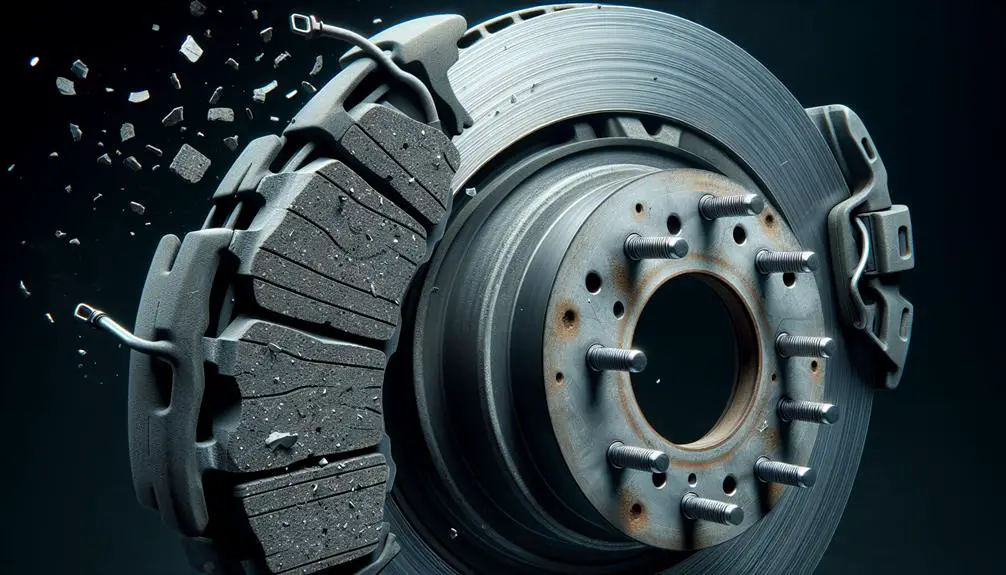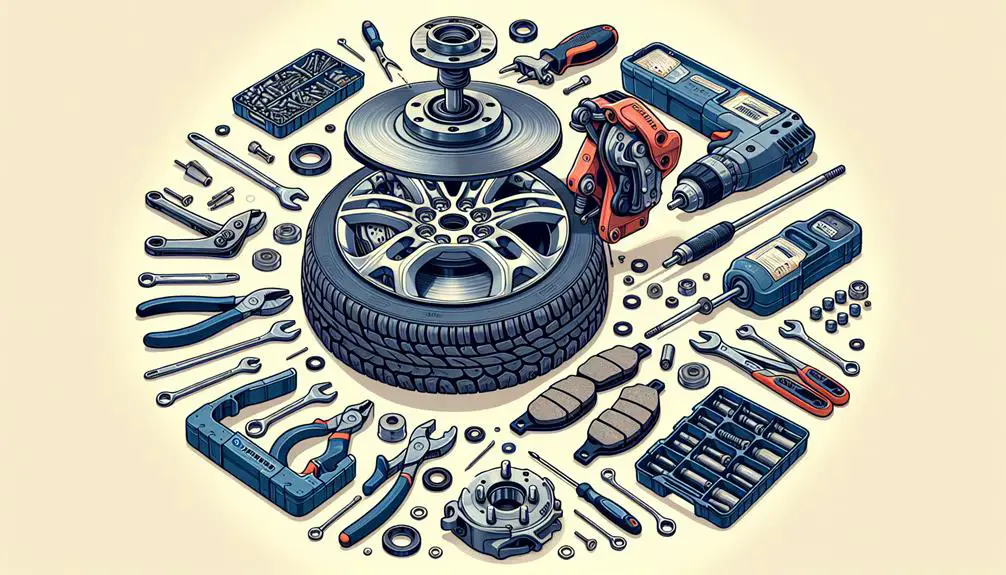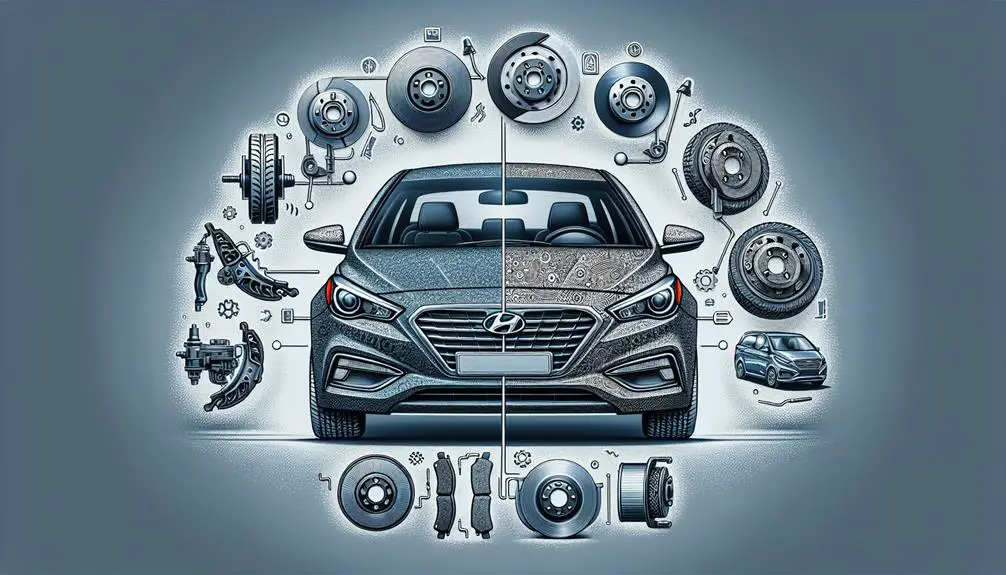Maintaining your Hyundai Sonata's braking system involves several key steps:
Identifying when brake pads and rotors need replacement is crucial. This can be done by listening for squeaking or grinding noises when braking, feeling vibrations or pulsations through the brake pedal, or noticing reduced braking performance.
Selecting the best components is important for optimal braking performance. High-quality brake pads and rotors will provide better stopping power, durability, and overall safety for your vehicle.
Understanding the replacement process is essential to ensure safety and enhance performance. Whether you choose to do it yourself or have a professional mechanic handle the job, knowing the steps involved can help you make informed decisions and maintain your Sonata's braking system effectively.
Signs of Wear and Tear

Identifying signs of wear and tear on your Hyundai Sonata's brake pads and rotors is vital for maintaining top braking performance. You don't want to let these essential components degrade too much, as they're integral to your safety on the road. Here's how you can spot the warning signs that it's time for a check-up or replacement.
To start with, listen for any unusual noises when you apply the brakes. A high-pitched squealing sound is a common indicator that your brake pads are wearing thin. This noise is actually designed to alert you, as many pads have built-in wear indicators that make this sound when they've reached a certain level of wear.
Another sign is a grinding noise, which usually suggests that the pads have worn down completely, and the metal parts are rubbing directly against the rotors. This can cause significant damage if not addressed quickly.
You should also pay attention to how your car feels when you brake. If you notice a vibration or pulsating sensation through the brake pedal or steering wheel, it's likely that your rotors are warped. Warped rotors can greatly reduce braking efficiency and should be checked out as soon as possible.
Lastly, don't ignore any changes in your braking performance. If your Sonata takes longer to stop than it used to, or if the brake pedal feels spongy or too hard to press down, these could be signs of wear on your brake pads and rotors.
Keeping an eye out for these symptoms and acting promptly can help guarantee your Hyundai Sonata remains safe and responsive on the road.
Choosing the Right Components
Having recognized the signs of wear on your Hyundai Sonata's brake pads and rotors, it's now time to focus on selecting the right replacements to guarantee peak performance and safety. Making the right choice isn't just about ensuring your car stops effectively; it's about connecting with your vehicle on a deeper level, ensuring every trip is as safe and enjoyable as the last.
When choosing brake pads and rotors, consider these three critical aspects:
- Material Matters: Your Sonata deserves the best. Opt for ceramic brake pads for quieter stops and less wear on your rotors. For rotors, high-quality cast iron or steel offers durability and performance. Remember, the right material not only extends the life of your brake components but also enhances your driving experience.
- Compatibility Is Key: Not all parts are created equal. Ensure the components you select are specifically designed for your Sonata's model year. Incorrect parts can lead to ineffective braking, putting you and your passengers at risk.
- Brand Reputation: Trust in brands that are renowned for quality and reliability. While it might be tempting to go for cheaper alternatives, investing in reputable brands means peace of mind, knowing your vehicle's braking system won't let you down when you need it most.
Choosing the right brake pads and rotors is a crucial step in maintaining your Hyundai Sonata's safety and performance. Don't compromise on quality; your life and the lives of those you share the road with depend on it.
Step-by-Step Replacement Guide

Once you've chosen the right brake pads and rotors for your Hyundai Sonata, it's time to tackle the replacement process step by step.
Initially, make sure your Sonata is securely parked on a flat surface and you've got your tools ready. You'll need a jack, jack stands, a lug wrench, and the appropriate socket set. Start by loosening the lug nuts on the wheel before jacking up your car. Once lifted, support it with jack stands and remove the wheel entirely.
Next, locate the brake caliper, which houses the brake pads. You'll need to remove the caliper bolts using your socket set. Carefully lift the caliper off the rotor and support it so it doesn't dangle by the brake line. This exposes the brake pads for easy removal. Slide out the old pads, noting how they fit in place for a smoother installation of the new ones.
Before installing the new brake pads, check the caliper piston. It might need to be compressed back into the caliper housing to fit the new, thicker pads. You can use a C-clamp or a dedicated tool for this task.
Now, it's time for the rotor. If it's held by screws, remove them. Take the old rotor off, replace it with the new one, and secure it if necessary.
Install the new brake pads, reattach the caliper, and bolt it securely. To conclude, reattach the wheel, lower your car, and tighten the lug nuts. Remember, it's important to pump your brakes a few times before driving to make certain the brake pads are properly seated.
Maintenance Tips
To keep your Hyundai Sonata's brakes in top condition, it's vital to follow a regular maintenance routine. This not only guarantees your safety on the road but also saves you money in the long run by preventing costly repairs. Proper care of your brake pads and rotors is vital. Here's how you can maintain them effectively:
- Regularly Check Brake Pads and Rotors: It's necessary to inspect your brake pads and rotors for wear and tear regularly. Look for signs of thinning brake pads or grooves and warping on the rotors. Catching these issues early can prevent more significant problems down the line and ensure your vehicle stops when you need it to.
- Clean Your Brakes: Over time, brake components can accumulate dust, debris, and rust, which can affect performance. Make it a point to clean your brakes periodically. This involves removing the wheels and using a brake cleaner to remove any build-up. This not only prolongs the life of your brake pads and rotors but also maintains optimal braking performance.
- Avoid Harsh Braking: Whenever possible, try to avoid sudden, harsh braking. Hard stops can cause excessive wear on your brake pads and rotors. Instead, aim for smooth, gradual stops. This practice not only extends the life of your brake components but also contributes to a more pleasant driving experience.
Following these maintenance tips will keep your Hyundai Sonata's brakes functioning smoothly and reliably, ensuring your peace of mind on the road.
Common Issues and Solutions

Even with regular maintenance, you might still encounter common issues with your Hyundai Sonata's brake pads and rotors; however, there are straightforward solutions to these problems.
One frequent concern is the wearing down of brake pads. You'll know it's time for a change if you hear a squealing noise or if your car takes longer than usual to stop. Don't worry; replacing brake pads is a routine procedure that any reputable mechanic can handle efficiently.
Another common issue involves the rotors. If your steering wheel shakes when you brake, it's likely because of warped rotors. This can happen from excessive heat during prolonged braking. The solution is either to have your rotors resurfaced, which evens out their surface, or to replace them if they're too worn down.
You might notice a grinding noise, which usually indicates that the brake pads have worn down completely, allowing metal to rub against metal. This is a serious issue that requires immediate attention, as it can compromise your vehicle's safety. Replacing both the brake pads and the damaged rotors is the best course of action in this scenario.
Enhancing Performance
After addressing common issues with your Hyundai Sonata's brake pads and rotors, you might wonder how to further improve your vehicle's braking performance. Enhancing this important aspect of your car can't only increase safety but also enhance your driving experience, giving you the confidence to handle your Sonata like a pro.
Here's how you can lift your brake system to the next level:
- Upgrade to High-Performance Brake Pads and Rotors: High-performance materials can greatly reduce stopping distances, providing a sharper, more responsive braking experience. This upgrade can make a world of difference, especially in emergency situations where every moment counts.
- Invest in Better Brake Fluid: Switching to a high-quality brake fluid can improve the efficiency of your braking system. Higher quality fluids have a higher boiling point, reducing the risk of brake fade during intense use. This means you'll maintain top braking power, even under tough conditions.
- Regular Maintenance and Inspections: Regular checks are your best defense against brake failure. Make certain your brake system is free from air, the pads aren't worn down, and the rotors are in good condition. This vigilance not only improves performance but also extends the lifespan of your braking system.
Conclusion
So, you've tackled replacing your Hyundai Sonata's brake pads and rotors like a pro. Remember, choosing quality components and following our step-by-step guide ensures your brakes are in top condition.
Don't forget regular maintenance to avoid common issues down the road. If you're aiming for enhanced performance, consider upgrading.
With these tips and a bit of elbow grease, you'll keep your Sonata stopping smoothly and safely. Drive confidently, knowing you've got this ensure maintenance task well in hand.